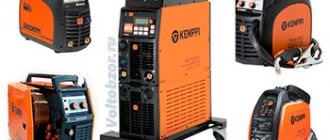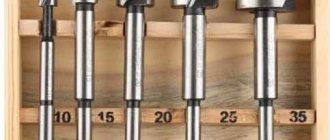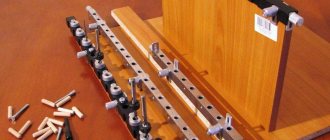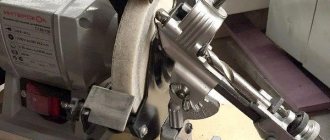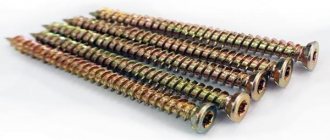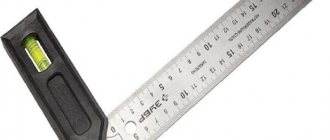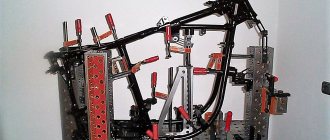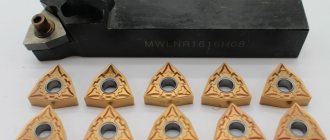Kinds
There are several types of jigs or templates for drilling, depending on the specifics of their use, design and scope of application.
By purpose
By area of use, conductors are:
- Furniture - designed for assembling furniture, drilling holes in furniture blanks, etc.
- For drilling pipes - the design features allow you to drill cylindrical surfaces.
- For working on tiles and tiles - often equipped with a water supply device to avoid overheating when working with diamond drills.
- For crowns - the templates on the jig are designed for drilling with crowns, and not with standard drills and drills.
- Universal - can be equally used for any job, withstands both wood and metal drills. Most often, the sleeves are made of steel.
By design
There are several common drilling template designs:
- Overlays - used for horizontal surfaces. They can be equipped with a lock, or without it - in this case, you need to additionally use a clamp. Some types of overhead jigs have an additional suction cup.
- Rotary - a more versatile type that can be used for cylindrical parts and surfaces. Holes can be drilled in horizontal, vertical planes, and at different angles.
- Sliding is a slide type hole scriber that does not require a locking device. Used in places where the template is impossible or difficult to fix.
How to choose
Do you use a drilling jig in your work?
I always want to try
When choosing a marker for drilling, it is recommended to pay attention to the following points:
- Tool material
As a rule, cheap conductors are made of plastic. However, this is an unreliable material that quickly grinds down and wears out. Therefore, it is recommended to buy a device with steel sleeves.
- Purpose
How highly specialized the tool is. You should focus on what type of work the conductor will be used for.
- Design
This point is closely related to purpose. If furniture assembly work is carried out, you may need both an overhead and a sliding tool, depending on the specific stage of assembly.
- Type of lock
Clamp or suction cup. For construction work on a vertical plane, a rubber suction cup is more suitable, which allows you to move the marker to any desired location.
Expert opinion
Torsunov Pavel Maksimovich
You should also focus on the reputation and name of the manufacturer. For example, the Russian one has gained popularity, which produces both universal and highly specialized conductors. Markers from well-known global tool suppliers – Bosch, Kreg, and others – are also popular.
Popular models
PRACTICE 247-026
This is one of the simplest and most inexpensive jigs, designed for drilling holes with a diameter of 4-10 mm. The tool is made of plastic, has a round shape with patterns of holes of different sizes around the circumference. There is a special rubber rim to collect dust and chips. Buyers of this conductor note its budget price and ease of use as advantages. The main disadvantage is rapid wear.
Oleg K. review:
“It’s a good tool for infrequent use. The holes are more accurate than without it. But the plastic wears off very quickly, and the grooves are larger than the drills themselves. Suitable as a disposable conductor, especially since the price is affordable"
Bison 29853
The jig is designed for use with diamond tubular drills. Hole diameters are 4, 6, 8, 10 and 12 mm. There is a rubber suction cup as a retainer. The tool is also equipped with the ability to force water supply to avoid overheating.
Among the positive features, buyers note:
- Affordable price.
- Sufficiently reliable fixation on ceramic surfaces.
- Drilling accuracy.
- Overheating insurance.
The main disadvantage of the device, like all conductors in the budget segment, is rapid wear. However, this is compensated by an affordable price, which makes it possible to consider such tools more as a replaceable consumable for repair work.
Dmitry S. review:
“I bought it for a bathroom renovation. It is attached securely enough and does not slip on the tiles. It drills accurately, no additional markings are necessary. Of course, it wears off quickly, and the drill starts to “walk” a little in the sleeve, but if used rarely, it’s a pretty good jig.”
PRACTICE 771-411
This instrument belongs to the Russian “Expert” series. It is used as a guide for diamond bits with a diameter of 14 to 70 mm. The conductor is made of steel; a rubber suction cup acts as a retainer. According to the manufacturer, thanks to the design of the guide, the side layer of diamond bits does not wear out. This is confirmed by the buyers of this conductor.
Vladimir P. review:
“A good and cheap instrument of domestic production. The suction cup does not slip, the guide does not play. What is typical is that the crown does not grind down, although I expected the worst from a steel sleeve. I recommend it as an affordable and well-made conductor for repair work."
Kwb Dubelprofi, 7580-00
The tool produced by the Czech company Kwb is more universal. It is equipped with templates for drilling holes from 3 to 12 mm. The bar acts as a parallel stop. There is a depth gauge. Despite the presence of a stop bar, owners report some difficulties in fixing the device. However, the tool is popular due to its low price and ergonomic use. On the plus side, good drilling accuracy is also noted.
Nikolay S. review:
“One more stop is missing to securely fix it, as well as a screw to tighten the stop. Therefore, to prevent the conductor from slipping, you need an assistant or a clamp. But it drills accurately; a depth gauge helps regulate the size of the hole. It can serve for a long time, since the templates hardly wear down"
Bosch 2607000549
The jig is designed for drilling holes for dowels. Templates include the most common diameters - from 3 to 12 mm. Designed for work on both wood and steel, therefore it is a universal jig. For fixation, the tool is equipped with a stop with a clamping screw, as well as a handle for ease of use. In general, reviews about this device are positive. The only drawback is the plastic material, which is prone to wear out quickly.
Vladimir T. review:
“It’s a good template, it’s much easier to work with. It is also quite easy to fix and does not slip off. I'm glad that there is a screw for adjusting the clamp. Over time, the holes wear down a little and play appears, but this is quite normal for a plastic tool.”
Kreg K3DGB
This is a more professional jig that allows you to drill holes in large diameter parts. The attachment is replaceable and is sometimes used as part of a Kreg drill kit. The design is designed for drilling both perpendicularly and at an acute angle. Owners note the reliability of the device and the versatility of its use.
Vasily S. review:
“As a tool for assembling furniture, it is indispensable. The guides are precise, nothing dangles or slips. I chose a jig specifically with the ability to drill at an angle of 45 degrees. The conductor itself is strong, I think it will last a long time. I bought a base for it, from the same company - Kreg Jig"
Kreg Kma3200
An overhead jig designed for drilling vertical holes when assembling furniture, repairing, etc.
Included are:
- The conductor himself.
- Clamp clamp.
- Restrictor ring.
- Positioning pin.
- Drill 1-1/4.
- Connecting strip.
Thus, in essence, this is a whole kit for accurate and high-quality drilling. The conductor also comes with a user manual for assembling and using the device. The tool has earned positive reviews from customers, mainly highlighting its accuracy and reliability.
Valery O. review:
“Great kit for renovation work. With his help I assembled the kitchen. The clamp is reliable, you don’t need to hold anything additionally. The drill sleeves do not play, and I don’t think they will wear out any time soon. The only drawback may be the price, and even then, it can’t be called exorbitant.”
Vertical or horizontal hole
Before drilling a hole, first securely fix the blade. This can be done using a vice or a workbench, but you can use a dowel.
The drilling procedure is as follows:
- The drill must be switched to drilling mode.
- Set speed.
- If a through hole is required to be drilled, a wooden block should be placed under the material.
- If you need to drill a blind hole, the depth and diameter must be suitable for the screw to be driven in.
- The drill must be used at a right angle. When the end is fixed in the block, you should switch the drill to maximum power mode.
To obtain a horizontal hole, you only need to move the workpiece.
Metal drilling: features
The key to good work is the correct choice of drill. Ordinary ones should be used for not entirely hard metal, for example, copper; for stainless steel, it is better to take drills made of titanium carbide. Besides:
- before drilling a thin plate, it must be secured between 2 pieces of wood;
- to facilitate the process and cool the drill, it is advisable to use lubricating oil;
- If you need to drill a hole in a pipe, it should be securely fixed and a wooden beam should be placed inside - this way the pipe will not flatten during work.
Drilling concrete: features
Every man has to drill concrete quite often in everyday life, for example, if he needs to hang a picture, hang a shelf, or attach a TV bracket to the wall. It is better, of course, to resort to a hammer drill or impact drill in this situation, but if the wall is up to 12 cm thick, a regular drill will do. So:
- When starting work, you should make sure that there are no communication systems in the drilling areas;
- Preference should be given to parts made from hard metal or alloys;
- When drilling encounters dense concrete areas, it is better to pierce them with a punch.
Drilling wood: features
Wood is considered the most pliable material, which can be easily sanded and can also be drilled. When working with a drill, you need to take care of special attachments.
Many repairmen are interested in: how to properly drill a perpendicular hole in wood? The process, it is worth noting, is by no means complicated. First of all, you need to mark with a pencil, identifying the points for drilling. Next, turn on the drill at full power - the hole can be easily drilled.
To make a groove in wood, it’s time to resort to a simple scheme:
- You need to mark a hole around the drill so that the center is located at a distance of approximately ½ of the diameter of the drill;
- the hole should be drilled to a maximum depth of 3 mm;
- each hole needs to be deepened;
- Use a file to remove all uneven places.
Drilling bricks: features
To drill through a brick wall, you need to proceed like this:
- make markings;
- place a core or an old drill at the marked points, hitting it a couple of times with a hammer to form a recess;
- You need to place the drill in the drill, turning on the impact mode;
- Holes should be drilled smoothly.
Drilling tiles: features
When working with such delicate material as tiles, the impact mode should be used with extreme caution. It is advisable to turn it off before work, otherwise you will not avoid chipping the tiles.
If you need to drill a small hole, you should give preference to special drills designed for working with glass and tiles. You need to drill a hole with such drills until it stops.
Conclusion
Thus, the jig has a number of obvious advantages in comparison with manual marking of holes for drilling:
- Saving time spent on marking.
- High accuracy.
- Easy to use.
Thanks to the use of a jig, it is possible to optimize the process of repair or construction work, as well as drill holes that cannot be properly marked manually - for example, at an angle of less than 90 degrees. A wide variety of choices allows you to choose the necessary marker for almost any job.
Self-centering jig
A simple template for making holes for dowels when assembling furniture panels or connecting other parts. Thanks to the guide pins, it automatically aligns precisely in the middle of the end of the workpiece, allowing you to drill exactly where you need it. The centering bushings are screwed into the threads. If desired, you can order a set immediately with a set of dowels and drills.
Price: from 795 rubles.
Buy

